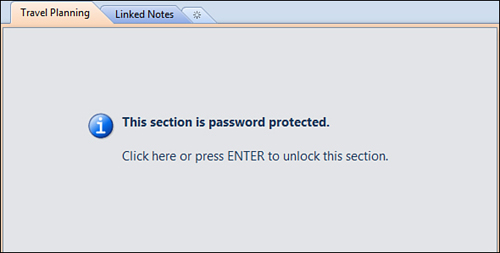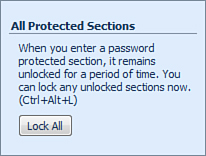Unlocking a Protected Section
When a section in your notebook was protected with a password, you must enter this password all the times that you want to turn over to this section still to look at his pages.
To unlock a section, do the following:
1. | Click the tab of the password-protected section that you want to view.
|
2. | When you see the password protection screen (see Figure 4), click the screen or press Enter.

|
3. | In
the Protected Section dialog box that appears, type the password for
the section, and then click OK. Remember that passwords in OneNote are
case sensitive. Upper- and lowercase characters must be entered exactly
as you typed them when you first created the password for the current
section. |
If you enter the wrong password or you typed the
right password incorrectly, OneNote displays a “Password is incorrect”
warning in the Protected Section dialog box and clears the Enter
Password field so you can try again.
When you type the correct password, OneNote unlocks the section and displays all of its pages.
|
The resolved and not protected sections are two different things. A not protected section does not have any password generated with it and can be looked by no matter whom with the access to the notebook in which it is stored, while a resolved section always has a password generated with it.
By default, a password-protected OneNote section
stays unlocked for up to 10 minutes of inactivity after you have
entered its correct password. After this time, the section will
automatically lock itself again. This timeout can provide an additional
layer of security, for example, if you’re called away from your
computer while viewing a protected section, especially if that computer
has no password-protected screensaver.
|
Locking All Protected Sections in a Notebook
If you’ve applied passwords to multiple sections in
your notebook and you want to lock them all again after viewing them,
you can do so with a simple command.
With one or more of your protected sections unlocked, do either of the following:
If the Password Protection task pane is
visible near the right side of the OneNote program window, click the
Lock All button under the All Protected Sections heading (see Figure 5).

On your keyboard, press Ctrl+Alt+L to lock all protected sections.